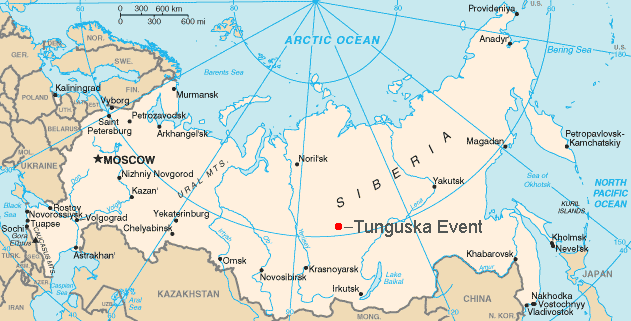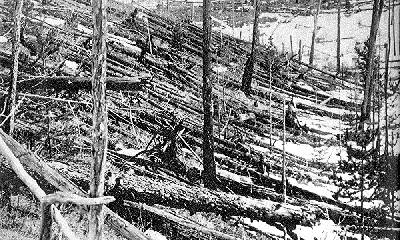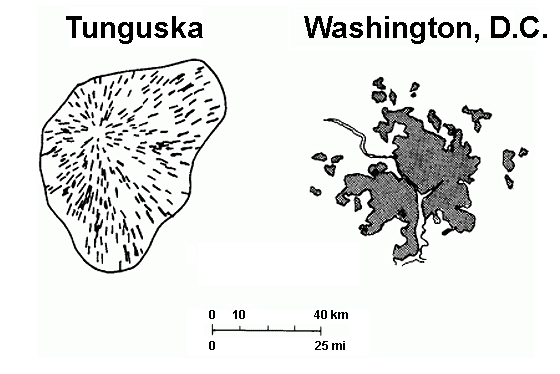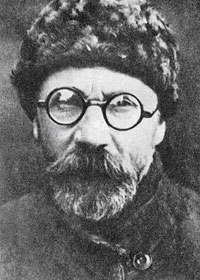Did you know that in 1908 in Siberia, one of the most catastrophic, mind-blowing (and mysterious) cosmic impact catastrophes everin the history of civilization occurred - and yet it wasn't widely known outside Russia (save for a few astronomy and research scientist enclaves) until around the 1970's? Even interested research parties didn't learn about or even set foot on the scene of disaster until 1921. It didn't make front page news in the papers when it happened because of the extreme remoteness of that region of Siberia. Also at play was the secretive, unsettled nature of Russia at the time (which of course only heightened the many conspiracy theories surrounding it today).
Trees flatten after the explosion
Even though there is much speculation and controversy about what exactly the mysterious Tunguska explosion of 1908 was, here are the presumed and most widely agreed-upon theories among the most level-headed experts: On June 30th, 1908, at 7:15am, in Tunguska (an extremely remote and almost zero-populated area of the central Siberian plateau) a huge gigantic meteorite (or perhaps comet) of some type exploded (at 40 megatons) six to eight kilometers above the earth's surface (presumably after coming in contact with the atmosphere layer) and it's subsequent impact instantly devastated 1,000 square kilometers of forest... felling trees outward in a radial pattern. The immediate fires burned for weeks ...eventually destroying a total of 2,150 square kilometers of forest, all of which remained scorched and flattened for decades (the immense damage is still easily visible today).
According to recordings at meteorological stations at the time, the seismic activity measured 5.0 on the Richter scale, and according to devices worldwide, the air compression wave went twice around the entire planet (bouncing both times). The blast itself, in whatever context it might have occurred, is estimated have been 40 megatons, which is 2,000 times the force of the atomic bomb exploded over Hiroshima in 1945. Even the asteroid impact that caused the great Berringer crater in Arizona (some 50,000 years ago) is only estimated to be 3.5 megatons. The mass of the object has been guessed at about 100,000 tons (and about 60 meters in diameter), but what exactly made up this mass is unclear (most agree it was probably a loose 'glob' of rocks and ice).
Tungus tribesmen and Russian fur traders who happened to witness the event from a relatively close range (it was a cloudless and clear day) reported seeing a bright, flaming object coming in from the sky at and angle, and then a giant, bright blast. According to some eyewitness accounts, a giant column of flame and smoke arose in the air from the impact spot. The force of first the heat wave and then the wind blast was enough to flatten huts and knock (burning and scorching) people and livestock airborne, and then back down to the ground again. Forty miles from the blast center at a town called Vanavara, people were thrown into the air by the shock wave. According to reports there, it shattered windows and collapsed ceilings. Near the town of Kansk (375 miles from the blast center), at a stop on the Trans-Siberian Railway, a train screamed to a halt when the engineer feared it would be thrown from its tracks by the violent shaking as passengers were jolted from their seats by the movement. The sound was deafening (there are reports of some people close by actually becoming deaf from the event). A series of thunderclaps could be heard even 500 miles away. And, although there were some serious injuries, to date there have been no records of human deaths from the event.
Leonid Kulik
A "black rain" showered the immediate area afterwards (the substance was probably condensation mixed with dirt and debris sucked into the swirling vortex of the explosion and then spat out again). The event caused all kinds of climate changes around the planet. Dust in the air at heights of from 40 to 70 kilometers caused high altitude noctiluscent, or "night-shining," clouds that illuminated much of the visible sky, mostly in Eastern Siberia and Middle Asia. Even in London at the time are newspaper account records of a night sky so luminous that "...one could read by it." Decreased visibility was reported worldwide, and in daytime of the most polluted atmosphere cased visible rings around the sun's glare. Also, obviously... brilliant sunsets were reported worldwide for weeks.
 The site of the impact has been escavated numerous times (Russian scientist Leonid Kulik was the first to brave the area in 1921), but no evidence of a huge meteorite has been found, although fragments of meteorite-like elements have been found in the area. More importantly... no impact crater of any type has been located. The trees in what is believed to be the impact site's exact center were stripped of their branches, but were oddly left standing amongst the miles of charred and flattened ones surrounding out from them (exactly like the effect of the bomb dropped at Hiroshima - which was also an airborne explosion). In the 1960s, a research troupe identified four smaller epicenters within the larger one. Each of the smaller epicenters has its own radial tree-fall pattern, and each presumably was caused by individual explosions during the chain of bursts. Most agree that all this adds up to a meteorite that was made up of loosely conjoined materials (ice, rocks, etc.) that exploded upon reaching the earth's atmosphere and obliterated into a zillion untraceable pieces... the force of this impact causing the immense destruction.
The site of the impact has been escavated numerous times (Russian scientist Leonid Kulik was the first to brave the area in 1921), but no evidence of a huge meteorite has been found, although fragments of meteorite-like elements have been found in the area. More importantly... no impact crater of any type has been located. The trees in what is believed to be the impact site's exact center were stripped of their branches, but were oddly left standing amongst the miles of charred and flattened ones surrounding out from them (exactly like the effect of the bomb dropped at Hiroshima - which was also an airborne explosion). In the 1960s, a research troupe identified four smaller epicenters within the larger one. Each of the smaller epicenters has its own radial tree-fall pattern, and each presumably was caused by individual explosions during the chain of bursts. Most agree that all this adds up to a meteorite that was made up of loosely conjoined materials (ice, rocks, etc.) that exploded upon reaching the earth's atmosphere and obliterated into a zillion untraceable pieces... the force of this impact causing the immense destruction.
The size and magnitude of the blast's destruction, and it's location and timing, are frightening to ponder. If it was a meteorite, it is the only event in the history of civilization when Earth has collided with a truly large celestial object (although what occurred before recorded civilization, and are likely to in the far future, are up for grabs). If the object had waited a mere few hours, the rotation of the Earth would have placed it's impact somewhere in Europe. Boom... half a million people wiped out in seconds, who would not have been able to see it coming at all. The historical ramifications of such an epic catastrophe (not to mention the theological ones) are incalculable.
The most notable theories throughout the ages have been the following:
1. The loose comet/asteroid theory. The most obvious and logical cause (discussed above).
2. Anti-matter: "Anti-matter" is like stuff from Superman's "Bizarroworld," where everything is opposite. It classifies as material with a reversed charge at the sub-atomic level. It is theorized to exist in very small quantities floating around in our universe, and has actually been created by scientists in laboratories. However, when anti-matter meets up with real matter; KA-BLOWIE! The theory here is that some wayward, drifting anti-matter came in contact with Earth and exploded when touching our thick, lower atmosphere. An explosion of this type would behave very similarly to one created by an atomic bomb. This idea was ruled out in the mid-60's as an anti-matter explosion of this classification would have lead to a significant rise in the amount of radioactive carbon-14 in the air. Researchers studying carbon rings on trees at the site did find a rise in the level of carbon-14 at the time... but no where near enough to signify an explosion of this category.
3. Mini Black Hole: some cosmologists theorize that "mini black holes" were created at the birth of our universe, and are just floating along aimlessly like little whirlpool ripples... not big enough to swallow whole galaxies, but powerful enough to wreck havoc with anything they come in contact with. Apparently some feel the Tunguska explosion could have been cause by one of these mini black holes passing through our planet like a ghost the entry point obviously being at Tunguska. This of course would mean that the black hole would have to come out the other side (which would be somewhere in the Atlantic Ocean assuming it went straight through the middle) where it would have produced a very similar explosion. Anyway... this theory has been debunked by everyone as being hopelessly naive for a lot of scientific jargon-y rules, plus there are no records of any explosion anywhere else in those areas of the planet at the time (and yes they were on and measuring stuff... even back then).
4. Blaming Nikola Tesla: Some theorize that Nikola Tesla, was testing out some sort of weird, fantasmigorical communication device, or super-scary "energy weapon" or "death ray" and made a big "...oops!" Tesla was known to be working on a sort of wireless torpedo, called an "telautomaton," which was a remote controlled boat he offered to the U.S. Navy for the purpose of carrying explosives to naval targets. An airborne version of the telautomaton device was under development as well. Some also believe that if there was a Tesla connection, and it was a weapon test... that he may have been pressured into it and then kept quiet.
Nicola Tesla
5. A UFO inadvertently crashing into the Earth, and it's nuclear-powered engine exploding into smithereens. This is the most obvious "wild" theory about the Tunguska explosion.This theory made famous by Russian engineer named Alexander Kazantsev who said it was an alien spacecraft from a dying planet Mars looking for a water on earth that actually crashed on tunguska because of that spaceship mechanical failure.Although he didn't have any evidence to back up the claim,many eye witness says that they have seen a large cylindrical object flaming with huge fireball flying above the tunguska before it finally explodes in the sky.Wait a minute,a CYLINDRICAL OBJECT ? really ?
Alexander Kazantsev
There have been a series of weird, ongoing biological consequences in the Tunguska region, presumably from the 1908 explosion. Following the blast there was accelerated growth of biomass in the region of the epicenter, and this accelerated growth has continued today. There also was an increase in the rate of biological mutations, not only within the center... but along the trajectory. Creepy abnormalities in the "Rh blood factor" of local Evenk groups (a native people to the area for centuries) have been found, genetic variations in certain local ant species are now being looked at, and genetic abnormalities in the seeds and needle clusters of at least one species of pine have been discovered there.
Tunguska in the present day
THE VERDICT
Something did explode on Tunguska in the year of 1908,but what exactly happen,we will never know.Even the scientist today have different opinions on this matter.But theory of comet,meteorite explosion was largely accepted among the scientist.But still,no fragments of comet or meteorite found on tunguska even to this day.Pretty strange considering the fact that if the comet or meteorite did caused the explosion,the stone debris of the explosion must have been found easily on the site,but they found nothing.So,the theory of comet / meteorite was questionable and debatable.Other theory by Alexander Kazantsev about an alien spaceship that explode,if that is true,why no spaceship debris found in the site ? Kazantsev counter this claim by saying that explosion was too powerful it destroyed everything,that's why nothing could be found.Considering the fact that after the explosion in 1908, it took 13 years eventually in 1921,the first scientist leonid kulik finally set foot on tunguska.By then,probably any evidence linking to the explosion is already gone. But some eye witness saw a large cylindrical object explode in sky of tunguska.That was something that could be taken into account.Could it an alien spaceship in the cylindrical shape that was explode in the sky of tunguska on 1908 ? Still,it open to any discussions.We just have to keep an open mind on everything...
s
s







No comments:
Post a Comment